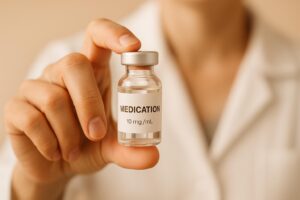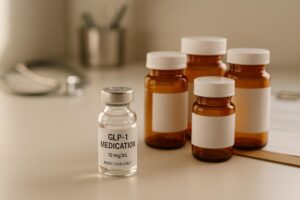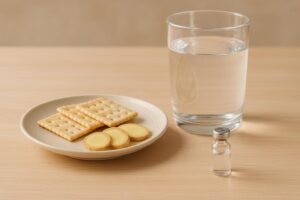Can You Eat Bread on GLP-1? Understanding Your Dietary Choices

Introduction
The question of whether you can eat bread while on GLP-1 medications is one that many individuals are asking. As we embark on this exploration, let’s consider the broader context: a growing number of people are using GLP-1 receptor agonists, such as semaglutide and liraglutide, to manage conditions like type 2 diabetes and obesity. These medications help regulate blood sugar levels and can aid in weight loss by promoting a feeling of fullness. However, they also introduce new dietary considerations that may influence everyday choices, especially when it comes to carbohydrates like bread.
In this blog post, we will dive into the relationship between GLP-1 medications and dietary choices, specifically focusing on bread and carbohydrates. We will examine the types of bread that may be more suitable, the nutritional aspects to consider, and how a balanced diet can enhance the efficacy of GLP-1 treatments. By the end of this post, you will have a clearer understanding of how to navigate your dietary choices while on GLP-1 medications.
Did you know that the type of bread you consume can significantly impact your blood sugar levels? Recent research highlights that different types of carbohydrates affect insulin response and satiety differently. This becomes particularly relevant when considering the use of GLP-1 medications, which aim to stabilize blood sugar levels and aid in weight management. The importance of diet cannot be understated; it plays a crucial role in maximizing the benefits of GLP-1 treatments.
As we delve into this topic, we aim to provide you with comprehensive insights into the relationship between bread consumption and GLP-1 medications. We will cover various aspects, including:
- How GLP-1 medications function and their impact on dietary choices
- The types of bread available and their nutritional profiles
- Recommendations for incorporating bread into a balanced diet while on GLP-1 medications
- Potential foods to avoid and their effects on blood sugar levels
Together, we will navigate these considerations to help you make informed choices on your journey toward better health.
Understanding GLP-1 Medications
What Are GLP-1 Medications?
GLP-1 medications, or glucagon-like peptide-1 receptor agonists, are designed to mimic the effects of a natural hormone that plays a crucial role in glucose metabolism. They are primarily used to manage type 2 diabetes and have been found effective in promoting weight loss. GLP-1 medications work through several mechanisms:
- Stimulating Insulin Secretion: They help the pancreas release insulin when blood sugar levels are elevated.
- Slowing Gastric Emptying: This function prolongs the feeling of fullness after meals, which can help reduce overall calorie intake.
- Reducing Appetite: By acting on the brain’s appetite centers, GLP-1 medications can help diminish hunger signals.
These properties make GLP-1 medications a valuable tool in managing both blood sugar levels and weight.
The Importance of Diet with GLP-1 Medications
Diet plays a pivotal role in maximizing the effectiveness of GLP-1 medications. Research indicates that a balanced diet rich in high-fiber foods, lean proteins, and healthy fats can complement the action of these medications. This is where the question of bread comes into play. Bread, particularly refined varieties, can lead to rapid spikes in blood sugar levels—a concern for anyone, especially those using GLP-1 medications.
Types of Bread and Their Nutritional Profiles
When considering bread in the context of a GLP-1 treatment plan, it’s essential to evaluate the types of bread available and their impact on blood sugar levels. Here’s a breakdown of various bread types:
White Bread
White bread is made from refined flour, which has been stripped of most of its fiber and nutrients. This type of bread can lead to rapid increases in blood sugar levels, making it less than ideal for those on GLP-1 medications.
Whole Wheat Bread
Whole wheat bread retains more nutrients and fiber than white bread. The fiber content helps slow digestion and can contribute to more stable blood sugar levels. While it may be a better option than white bread, portion control is still important.
Sourdough Bread
Sourdough bread undergoes a fermentation process that can lower its glycemic index compared to other breads. This means it may have a less pronounced effect on blood sugar levels, making it a potentially more suitable option for individuals using GLP-1 medications.
Multigrain Bread
Multigrain bread, made from a variety of grains, can offer additional nutrients and fiber. However, it’s important to check the ingredient list, as some multigrain breads may still contain refined flours that can spike blood sugar.
Gluten-Free Bread
For those with gluten sensitivities or celiac disease, gluten-free breads are a necessity. However, these can vary widely in their nutritional content and glycemic impact, so it’s crucial to read labels carefully.
Incorporating Bread into a Balanced Diet
Moderation is Key
If you’re wondering, “Can I eat bread on GLP-1?” the answer is nuanced. The key lies in moderation and the type of bread you choose. Here are some tips for incorporating bread into your diet while on GLP-1 medications:
- Choose Whole Grains: Opt for whole grain or sourdough varieties over white bread. These options are higher in fiber and more beneficial for blood sugar management.
- Watch Portion Sizes: Even healthier bread options can contribute to calorie intake. Be mindful of portion sizes to maintain balance in your diet.
- Pair with Protein and Healthy Fats: Combine bread with protein-rich foods (like eggs or lean meats) and healthy fats (like avocado) to help stabilize blood sugar levels and promote satiety.
- Include Fiber-Rich Toppings: Opt for toppings that are high in fiber and nutrients, such as hummus, nut butter, or fresh vegetables, to enhance the nutritional value of your meal.
- Listen to Your Body: Pay attention to how your body responds to different types of bread. If you notice discomfort or spikes in blood sugar, it may be worth adjusting your choices.
Foods to Avoid
While you can incorporate bread into a GLP-1 diet, it is equally important to recognize foods that can hinder your progress. Some foods to limit or avoid include:
- Sugary Foods and Beverages: These can lead to rapid increases in blood sugar and negate the benefits of GLP-1 medications.
- High-Fat Foods: Fatty foods can slow gastric emptying and exacerbate gastrointestinal side effects associated with GLP-1 medications.
- Refined Carbohydrates: Foods like white rice and pastries can spike blood sugar levels and should be consumed sparingly.
Meal Planning for Success
Meal Frequency and Timing
Eating smaller, more frequent meals can be beneficial for those on GLP-1 medications. This approach can help manage hunger levels and prevent discomfort associated with larger meals. Incorporating a variety of nutrient-dense foods throughout the day will ensure you’re receiving the necessary vitamins and minerals to support your overall health.
The Role of Fiber
Incorporating fiber into your meals is crucial when on GLP-1 medications. Foods rich in fiber help promote digestive health and can mitigate some of the gastrointestinal side effects that may arise from these treatments. Consider including the following fiber-rich foods in your diet:
- Fruits and Vegetables: Opt for a variety of colors and types to ensure a wide range of nutrients.
- Whole Grains: Incorporate options like quinoa, brown rice, and oats into your meals.
- Legumes: Beans, lentils, and chickpeas are excellent sources of both fiber and protein.
Conclusion
In summary, the question of whether you can eat bread while on GLP-1 medications ultimately depends on the type of bread and how it fits into your overall dietary plan. Whole grain, sourdough, and multigrain varieties can be incorporated in moderation, while refined and white breads should be limited due to their potential impact on blood sugar levels.
A balanced diet rich in fiber, lean proteins, and healthy fats, combined with the appropriate use of GLP-1 medications, can enhance your health and weight management journey. By making informed choices and being mindful of your body’s responses, you can effectively navigate your dietary options while on GLP-1 treatments.
FAQ
Can I eat white bread on GLP-1 medications?
While it’s possible to include white bread in your diet, it is best to limit its consumption due to its potential to spike blood sugar levels. Opt for whole grain or sourdough options instead.
What are some bread alternatives I can consider?
Alternatives include whole grain bread, sourdough, or even wraps made from whole grains. Always check the nutritional content to ensure they align with your dietary goals.
How can I manage cravings for bread while on GLP-1 medications?
Consider incorporating high-fiber foods and healthy fats into your meals to promote satiety. You can also experiment with healthier bread alternatives to satisfy your cravings.
Is it necessary to avoid all carbohydrates while on GLP-1?
Carbohydrates are an important part of a balanced diet, but it’s crucial to choose high-fiber, nutrient-dense options and monitor portion sizes for better blood sugar management.
Should I consult a healthcare provider about my diet on GLP-1 medications?
Absolutely! Working with a healthcare provider or registered dietitian can help you create a personalized meal plan that complements your treatment and supports your health goals.
At TrimRx, we are dedicated to helping individuals embrace healthier lifestyles through personalized, medically supervised care. If you are curious about how our weight loss solutions can support your journey, consider taking our free assessment quiz. Together, we can explore the best options tailored just for you!

Transforming Lives, One Step at a Time
Keep reading
Ultimate Guide to Semaglutide Dose Customization
This guide explores semaglutide dosing for diabetes and weight loss, emphasizing personalized adjustments for optimal results.
6 Common Drug Interactions with GLP-1 Medications
Learn about six common drug interactions with GLP-1 medications and how to manage potential risks for safe treatment.
Mounjaro Insurance Coverage: What to Know
Learn how insurance coverage for Mounjaro varies based on diabetes treatment and weight loss, along with tips for approval and cost-saving options.
Semaglutide vs. Tirzepatide: Max Dose
Explore the differences between two weight loss medications, their maximum doses, effectiveness, and safety profiles for better health outcomes.
GLP-1 Diet Plan: 7-Day Meal Guide
Learn how to effectively pair GLP-1 medications with nutritious meal planning for weight loss, improved digestion, and stable blood sugar.
Nausea and GLP-1 Medications: Solutions That Work
Learn effective strategies to manage nausea from GLP-1 medications, including dietary tips and the importance of personalized dosing.
5 Signs GLP-1 Medication Is Working for You
Learn the key signs that indicate your GLP-1 medication is effectively aiding weight loss, appetite control, and blood sugar management.
Plateau Problems: Restarting Weight Loss
Stalled weight loss on GLP-1 medications is common but manageable. Explore strategies to break through plateaus and regain momentum.
Body Fat Percentage Estimator – Know Your Stats
Estimate your body fat percentage in seconds with our free tool. Just input your height, weight, and more for instant results. Try it now!









